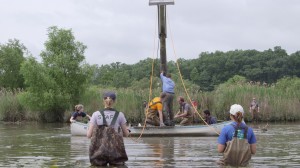
Local osprey are being outfitted with tracking devices so you and researches can monitor their travels, a new online learning opportunity will improve your knowledge of lakes, and researchers are predicting another severe algal bloom in Lake Erie this summer. Oil and gas pipeline accountability has been in the news a lot lately. Here we pulled together three articles that will catch you up on the latest happenings. And that is what is News to Us.
DNR monitoring osprey chick migration with GPS. Several osprey chicks have been outfitted with backpacks to help monitor the bird’s movements and growth. Two of the four chicks that will be monitored are from a nest in Kensington Metropark in Milford. There is a site where you can track the birds too at michiganosprey.org.
Introduction to Lakes course coming soon to a computer near you. With over 11,000 inland lakes, Michigan is home to many lake enthusiasts. If that describes you and you have always wanted to know more, Michigan State University Extension is now offering an online course providing in introduction to lakes.
‘Severe’ algal blooms forecast this summer on Lake Erie. Researchers are predicting a more significant algal bloom this year than the one last summer that shutdown Toledo’s water supply for several days. The bloom won’t necessarily lead to issues with drinking water but will certainly impact recreation on Lake Erie and the organisms that live in the lake. Phosphorus runoff and heavy rains in June are two major contributors to the severity of the bloom. Conservationists are targeting large livestock operations for phosphorus reduction.
July has been a big month for news on oil and gas pipelines in Michigan. Here is a sampling of articles sharing pieces of the larger issue of moving oil through our state’s waterways.
- Life 5 years after the nation’s worst inland oil spill – NPR’s Environment Report revisits the Kalamazoo River oil spill which is the largest inland oil spill in US history caused by a break in an Enbridge pipeline that traversed this waterway.
- Report calls for heavy crude oil ban in Straits of Mackinac pipeline – The Michigan DEQ led a special task force that released a report last week on the status and future of pipelines in the state. Of particular focus is the Enbridge pipeline that runs through the Straits of Mackinac. Some say the recommendations are a big step in the right direction for safety and accountability. Others assert it does not go far enough to protect our freshwater resources.
- National Wildlife Federation to Sue Dept. of Transportation over Oil Pipeline Oversight Failures — On the heels of this report, the NWF announced they plan to sue the federal government for failing to uphold the Oil Pollution Act which requires approval of a safety plan for pipelines which travel in, on or under inland waters. This lawsuit comes after much scrutiny and investigation into the safety of the Enbridge pipeline in the Straits of Mackinac.



